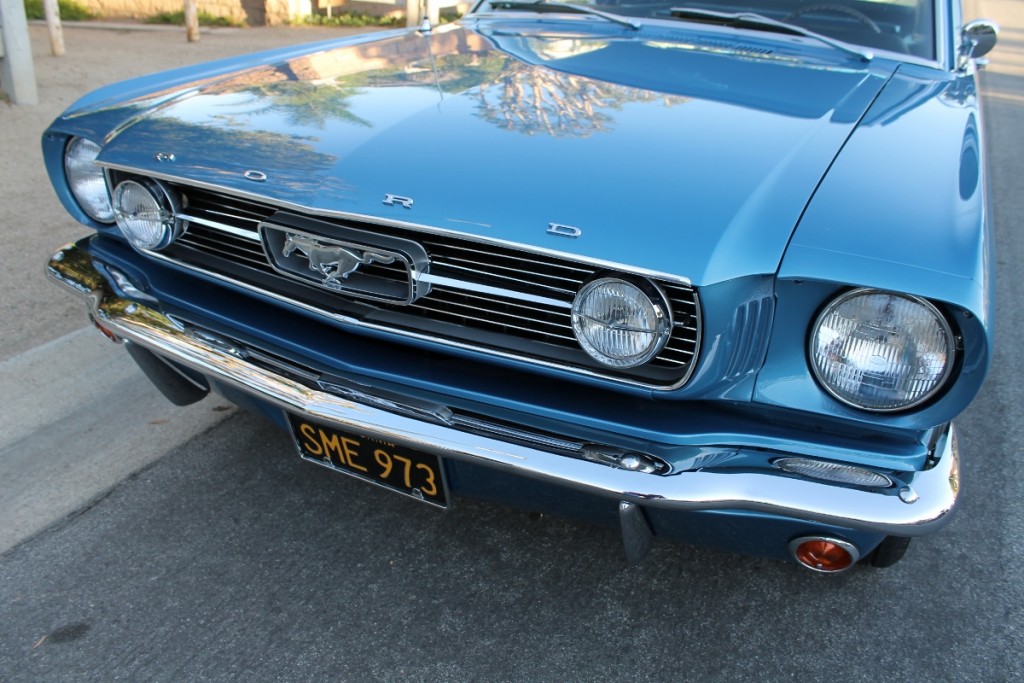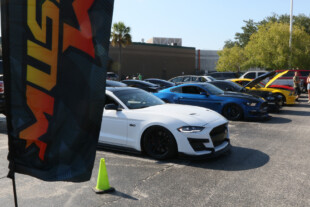A Rare Hi-Po Mustang restored to perfection
Words and Photos: Cam Benty
The term “Pony Car” is rarely used today, but starting in March 1964, a new category of car was launched with the new Ford Mustang. It was to be followed by a large number of similarly sized cars including the Camaro, Challenger, Camaro, Cougar and others. All of these models were to follow the Mustang, a little car that used plenty of carryover parts from its sister vehicle, the Falcon. But it had one thing the Falcon didn’t – it was strikingly good looking.

This Sapphire Blue ’65 Mustang is a one-off machine. Because of the documentation which stated it was a custom paint hue, it could have been painted any color offered by Ford that year. It is in fact ’65 Thunderbird Sapphire Blue.
The brainchild of legendary car guy Lee Iacocca, the Mustang lit a fuse for a generation of Baby Boomers who had come of age and loved building and modifying cars. The car was light, fun to drive, and had fair power from the small V8 engine that powered it. Best of all, it looked cool — which for this generation was a big deal. How big? Well in all, 559,451 were sold. That trend continued in 1966, and only 18 months after the Mustang was initially released, the one millionth Mustang was built. Yep, a cool million “ponycars” unleashed on the American (and world) population.
Kicking the Mustang into high gear was the launch of the Shelby GT350, a car forced on Shelby by Iacocca as part of his “deal” with Ford. Shelby really wanted to build the Cobra on the English AC Bristol chassis. In 1963, he had convinced Ford he could dominate racing with a 289c.i. Ford V8 stuffed into the tiny AC. It worked. Cobras, as they were called, were amazing fast and in 289 form, dominated racing. Shelby was happy. Ford was happy. But Ford wanted something more — and that was the GT350.
Shelby hated the idea. To him, the Mustang was “a secretary’s car.” Not fast and not a race car. Nevertheless, Shelby did as instructed and built the GT350 by stripping out the comfort and stuffing in the hottest 289c.i. engine in the lineup and upping the power from 271 to 306 hp. With a host of suspension changes meant for racing, a cool hood, raucous exhaust, racing stripe package, and performance wheel/tire package, it made Ford happy. Just to make it worthy of the Shelby name, he created a few “R” type GT350s that are highly prized today. In fact, if you happen to have a real ’65 GT350 (562 were produced), when restored to original condition, you have a car nearing $300,000 today.
Mustang Man
A regular customer of Mark’s Custom Rod Garage in Huntington Beach, California, Hogan Hammerstrom loved Mustangs — and Shelbys. A collector of rare muscle cars and cool customs, he can enjoy these cars as they are meant to be. The ’65 Mustang you see here reflects a very cool restoration enhanced with some rare wheels and “Red Band” tires — not unlike folks might have added back in 1965.
The original ’65 “K” code Mustang features all of the original, date-coded parts that would be found on a vehicle of this lineage. To verify a “K” code Mustang is easy — a deeply stamped K in the VIN is found on the top of the inner fender well. As one would say giving directions to a stranger, “You can’t miss it.” That branding meant a couple of things right off the bat: 1) the original owner coughed up the extra $442 that was required to add that option to his vehicle, and 2) that this is one of the rarest of the Mustang vehicles, with only 7,273 K code cars reaching the end of the assembly inline in 1965, and a little more than 13,000 from launch in 1964 through the end of 1966.
The Hi-Po Mustang (which is how the “K” code cars are more commonly known) was rated at 271 hp/316 lb-ft using the 289c.i. engine. The first of the Hi-Po Mustangs was constructed in June 1964 and was a full 61 hp hotter than the “D” code option. The newest option for the Mustang gave Ford another shot at marketing the hottest vehicle in their line-up, stating in their brochures that the Hi-Po Mustang was for those buyers “who would settle for nothing than top performance. Buyers intending to enter competitive events such as gymkhanas or rallys will appreciate the engine’s breathtaking acceleration, over 600 feet in the first 10 seconds from a standing start.”
Power Parts
The original Hi-Po 289 engine featured a host of performance upgrades, including 10.5:1 compression, flat top aluminum pistons, heavy duty connecting rods, and higher-nodular cast iron crankshaft with larger front counter weighting, but still retaining the two-bolt main bearing caps. Topping it off was a cast iron intake manifold and 4100 Autolite four-barrel carburetor rated at 600 cfm and equipped with an open element air cleaner and dual point distributor — highly advanced for the time.
One of the more difficult parts to duplicate with this restoration was the dual exhaust system that utilized an H-pipe and a pair of tailpipe-mounted mufflers. Amazing by today’s standards, the tail pipe/muffler sections were power-robbing-tiny, necking down to about a one-inch diameter. These parts, which were found after significant hunting, were clearly one of the first modifications to the Hi-Po ‘Stangs — and with good reason. But, on a careful restoration, these tail pipes sections are a key element.
Underhood detail is one of the things that sets this restoration apart. Note the attention to correct stampings, color, and even parts, like the very hard to find dual point distributor.
Chassis Upgrades
As with all 289c.i. engines offered in the first generation Mustangs, a Ford Top Loader 4-speed transmission was used — the Hi-Po version receiving the close ratio, 2.32:1 first gear compared to the 2.78:1 first gear for the 210 hp model. While the Top Loader transmission was overkill for these less-than-300-hp engines, the 9-inch rear end was unbreakable in this combination. For 1965, final drive gearing of 3.50, 3.89, and even 4.11:1 ratios could be ordered.
Mustang’s suspension carried a number of parts from the Falcon, but not the spring rates. That was especially true for the Hi-Po Mustang that had their own specific front coil (leaping from 89 to 101 lbs./in.) and rear leaf spring rates (moving from 101 to 130 lb./in.) for the performance driving implied by ordering this “expensive” option. Heavier shocks were employed, the front sway bar increased from 0.69-inch to 0.84-inch diameter, and the steering ratio was reduced to 22:1. Most Hi-Po Mustangs opted for the 11-inch front disc brakes over the standard drum brakes, but power assist was not available, interestingly enough.
The factory Hi-Po Mustang featured a five-lug 14×5-inch styled steel wheel with dual “Red Band” 6.95×14 tires. Here is where Hammarstrom strayed from the original, finding a very rare set of real magnesium five-spoke wheels. Lovingly restored and checked for safety, Mark Oja cleaned (this is the natural magnesium coloring) and wrapped them with original style tires featuring the factory-look red bands. The appearance is pure throwback — just the look he wanted.
Outside
One of the most unique points of this particular Mustang is the fact that when ordered, the car’s documentation states it was a custom color, something specified by the buyer and not from the usual factory palate of preferred hues. As originally constructed, the car was painted 1965 Ford Thunderbird Sapphire Blue, making this an extremely rare Mustang. Mark Oja carefully mixed up a matching PPG coloring and draped the now-perfect body with this interesting color combination, along with the GT stripe package.
While the car was amazingly clean when it arrived at Custom Rod Garage, all of the bodywork was inspected and anything that was not perfect was replaced with New Old Stock (NOS) components. As is the case with most things Oja does, both the things you can see and those you can’t are executed to perfection.
The final product is an amazing throwback honoring what turns out to be a very rare Mustang in a year when over half a million Mustangs rolled off assembly lines all around this country. The “K” model, Hi-Po Mustang was the precursor for the Shelby GT350 that was to debut months after the Hi-Po (which again were first released in June 1965). With the GT350 carrying a much higher price tag, the “K” was a happy middle ground for savvy customers. Smart folks!
















